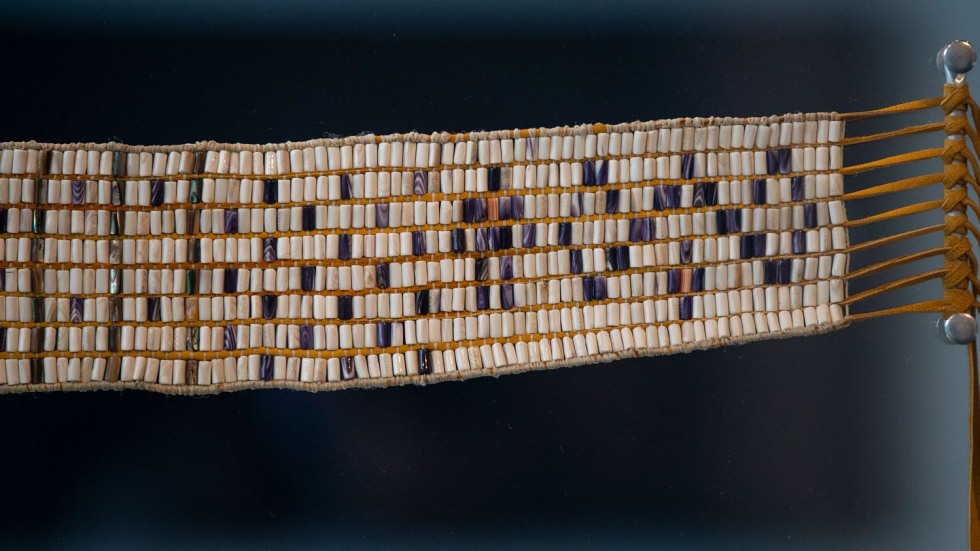The show runs from now to October 24, free and open to the public at the Granoff Center for the Creative Arts
Brown University
.jpeg?h=47c8e2b4&itok=Wzs9To7t)
Michelle Cook, left, created informational panels about wampum and UNDRIP for the exhibition. Hartman Deetz, right, created the wampum belt itself. Photo courtesy of Ockway Bay Wampum.
An exhibition at Brown University’s Granoff
Center for the Creative Arts draws compelling connections between Native
artistry, Indigenous traditions and a 2007 United Nations resolution on global
Indigenous peoples’ rights.
“The Beads
that Bought Manhattan: The United Nations Declaration on the Rights of
Indigenous Peoples,” is on view and open to the public in the
Granoff Center’s Cohen Gallery through Sunday, Oct. 24. It is presented by
the Brown Arts Institute in
collaboration with the Native
American and Indigenous Studies Initiative.
The
exhibition’s focal point is a belt made of deerskin, artificial sinew and
wampum — cylindrical beads made from quahog clam shells — that symbolizes
and celebrates the United Nations Declaration on the Rights of Indigenous
Peoples (UNDRIP), adopted in 2007.
The
belt’s creator, Hartman Deetz, said making wampum is more than an art form.
It’s also a symbol of his identity and ancestral history.
“I was about 8 or 9 years old when my grandfather first took me out to dig clams,” Deetz said. “This was a part of my summers, a part of my cultural heritage, gathering clams along the same banks as my ancestors had for thousands of years. Now, decades later, another part of my cultural heritage has come from the hard-shell quahog clam: the art of wampum.”
Deetz,
a member of the Mashpee Wampanoag Tribe based in Southeastern Massachusetts,
said his ancestors once used wampum as a form of currency, trading intricate
shell jewelry, clothing and accessories with nearby tribes and European
settlers. They would often create belts made of wampum, sinew and deerskin to
symbolize inter-tribal pacts to maintain peace or share stewardship of the
land.
When
the United Nations adopted UNDRIP in 2007, Deetz felt compelled to follow in
his ancestors’ footsteps. His wampum belt — which at the center features
46 beads to represent UNDRIP’s 46 articles — frames the declaration as a
modern-day “treaty” between nations.

Forty-six individual purple beads in the middle of the wampum belt represent UNDRIP's 46 articles, Deetz said. Photo: Nick Dentamaro/Brown University
“Indigenous
peoples in the U.S. are still unable to say no to development and extraction
projects that occur within the traditional and ancestral territories they use
and occupy,” Cook said. “We need to pressure decision-makers and financial
institutions to make real their human rights rhetoric and protect the human
rights and cultural survival of Indigenous peoples.”
The
exhibition is free, open to the public and on view through Sunday, Oct. 24, at
the Granoff
Center’s Cohen Gallery at 154 Angell St in Providence. The
gallery is open Monday through Friday from 8:30 a.m. to 10 p.m., Saturdays from
noon to 6 p.m. and Sundays from noon to 8 p.m. The gallery will be closed on
Monday, Oct. 11, in observance of Indigenous Peoples’ Day.
Deetz
and Cook will lead a free public
conversation on the exhibition on Tuesday, Oct. 12, at 6 p.m.
in the Granoff Center’s Martinos Auditorium. A reception in the Cohen Gallery
will follow.
“The Beads that Bought Manhattan” marks one of several Brown-hosted fall events and programs focused on Indigenous peoples.